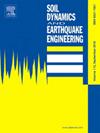Dynamic and pseudo-static analysis of shield tunnels in liquefiable ground with nearby aboveground structures
IF 4.2
2区 工程技术
Q1 ENGINEERING, GEOLOGICAL
引用次数: 0
Abstract
The shield tunnel is one of the most prevalent types of urban underground tunnels, which frequently traverses liquefiable ground and comes in vicinity of aboveground structures, presenting substantial challenges for their seismic performance. This study employs high-fidelity dynamic numerical analysis and simplified pseudo-static analysis for shield tunnels with and without nearby aboveground structures in liquefiable ground, to identify the effect of aboveground structures on shield tunnel response, and propose a practical seismic analysis method for shield tunnels that can consider the influence of aboveground structures. In dynamic analysis, a plasticity constitutive model is employed to simulate liquefiable soil, and a modeling method capable of depicting the reinforced concrete segments and joints is employed to simulate shield tunnels. Results indicate that aboveground structures have a substantial influence on shield tunnels, which requires sufficient consideration in seismic design. An aboveground structure located directly over the tunnel can affect the shield tunnel's vertical displacement, lateral compressive deformation, joint deformation, and internal force. An aboveground structure located over to the side of the tunnel can affect the shield tunnel's horizontal displacement, rotation, racking deformation, joint deformation, and internal force. The traditional displacement-based pseudo-static analysis method is shown to perform poorly in evaluating in seismic response of shield tunnels in liquefiable ground with nearby aboveground structures, due to inadequate consideration for the complexities of structure-soil-tunnel interaction. A modified simplified method is proposed to account for the influence of liquefiable soil and aboveground structures based on the understanding of seismic behavior of the system.
可液化地面附近有地上构筑物的盾构隧道动、拟静力分析
盾构隧道是最常见的城市地下隧道类型之一,它经常穿过可液化的地面,并且靠近地面上的结构,对其抗震性能提出了很大的挑战。本研究采用高保真动力数值分析和简化的拟静力分析方法,对可液化地表附近有无地上结构的盾构隧道进行分析,识别地上结构对盾构隧道响应的影响,提出一种考虑地上结构影响的实用盾构隧道地震分析方法。在动力分析中,采用塑性本构模型模拟可液化土,采用能够描绘钢筋混凝土管片和节点的建模方法模拟盾构隧道。结果表明,地上构筑物对盾构隧道的影响较大,需要在抗震设计中充分考虑。位于隧道正上方的地上构筑物会影响盾构隧道的竖向位移、侧向压缩变形、节理变形和内力。位于隧道一侧的地上构筑物会影响盾构隧道的水平位移、旋转、货架变形、接缝变形和内力。传统的基于位移的拟静力分析方法由于没有充分考虑结构-土-隧道相互作用的复杂性,在可液化地面附近有地面结构的盾构隧道地震响应评价中表现不佳。在了解体系抗震性能的基础上,提出了考虑可液化土和地上结构影响的改进简化方法。
本文章由计算机程序翻译,如有差异,请以英文原文为准。
求助全文
约1分钟内获得全文
求助全文
来源期刊

Soil Dynamics and Earthquake Engineering
工程技术-地球科学综合
CiteScore
7.50
自引率
15.00%
发文量
446
审稿时长
8 months
期刊介绍:
The journal aims to encourage and enhance the role of mechanics and other disciplines as they relate to earthquake engineering by providing opportunities for the publication of the work of applied mathematicians, engineers and other applied scientists involved in solving problems closely related to the field of earthquake engineering and geotechnical earthquake engineering.
Emphasis is placed on new concepts and techniques, but case histories will also be published if they enhance the presentation and understanding of new technical concepts.
 求助内容:
求助内容: 应助结果提醒方式:
应助结果提醒方式:


